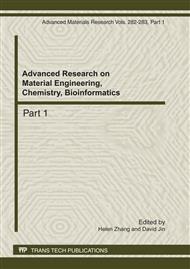p.444
p.449
p.453
p.457
p.461
p.466
p.470
p.474
p.478
Effects of Different Pore-Extending Methods on Morphology of Anodic Aluminium Oxide Templates
Abstract:
Anodic aluminium oxide (AAO) templates were fabricated via a two-step anodization method. On the basis of getting the optimum preparation parameters of AAO templates, effects of two different pore-extending methods on morphology of AAO templates were studied. Field emission scanning electron microscope (SEM) was used to research surface morphology of AAO templates. The SEM images indicated that different pore-extending methods had a significant influence on morphology of AAO templates. The shape of nanopores of AAO templates was cylindrical after floating pore-extending method, but it was truncated cone-shaped with one dimensional gradient using immersed pore-extending method. Meanwhile, mechanism of different pore-extending methods on morphology of AAO templates was elucidated.
Info:
Periodical:
Pages:
461-465
Citation:
Online since:
July 2011
Authors:
Keywords:
Price:
Сopyright:
© 2011 Trans Tech Publications Ltd. All Rights Reserved
Share:
Citation:


